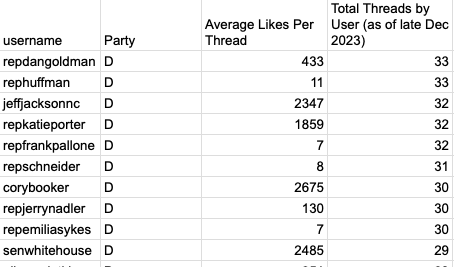Unravelling Congressional Threads
Since Elon Musk took over X (formerly known as Twitter), question marks have arisen pointing to the app’s sustainability for the foreseeable future. Purely anecdotally, the Iowa caucuses were the first election in a long time where Twitter did not seem like the central newsgathering place.
As political Twitter declines, other competitor apps have emerged. We have seen elected officials posting on LinkedIn, analysts moving to private Discord servers, and TikTok influencers brought to the White House. However, in terms of replicating what used to be offered by Twitter, the best option may be Meta’s Threads (built on top of Instagram), which currently comes closest to the scope, depth and userbase that Twitter had.
We have seen through our previous data just how reliant politicians are on social media to reach their constituents at the local, state, and national level. With Threads gaining some steam as an X competitor in the past year, we wanted to see which Members of Congress are taking advantage of it and relevant trends surrounding it. Here’s what we found, and you can access the full data here.
Takeaway 1: A Close-Knit Community
The first question people may ask themselves when looking at our data: who is on threads more?
Of the 177 accounts we analyzed (total number of Members of Congress actively on Threads when we conducted the analysis in late December 2023), a whopping 138 were Democrats compared to a meager 39 Republicans. Is it as simple as Democrats being more in-tune with social media or is it specific to Threads. Democrats very well could have begun flocking to Threads as a reaction to Musk taking over, given his affliction to push politics that pander to the far right, and seen Threads as the closest facsimile.
Time will tell if Republicans see Threads as a viable resource to reach constituents and follow Democrats in suit.
Top ten Threaders as of data collection
Takeaway 2: Blue Engagement Bursting at the Seams
While it is not shocking that Democrats have a higher average amount of likes on Threads post, given that more of them have migrated, the disparity between Democrat accounts and Republican accounts is.
Extreme outliers on this list such as Rep. Alexandria Ocasio-Cortez sweep the competition, averaging over 10,000 likes per post, but Democratic dominance on threads continues into the median numbers as well.
For example, the first Republican only appears at number 43, Senator Tommy Tuberville, with an average of 177 likes per post. Rep Tina Smith from Minnesota is ranked one spot above him but averages nearly 15 more likes per post.
What’s more is the lack of continuity among Republicans on the app. The next Republican is Matt Gaetz at 51st, followed by Ted Cruz at 68th. These numbers continue to reveal that Republicans are not able to replicate the efficiency of outreach that Democrats have on Threads. Their median member gets only 2 likes per post, whereas for Democrats that number is 28.
You can see in the below graphic that even though there are some Republicans that Threads as much as many Democrats (the Y-axis), few receive the average likes that many Democrats get (the X-axis).
Takeaway 3: Threading in the Right Direction?
The last element to consider about this data concerns user retention as it gives us a lens to look forward with. When looking at the amount of Threads posted by user, once again Democrats take the crown. While this does not necessarily indicate that one side is more likely than the other to return to Threads on a consistent basis, it does show that Democrats have made more of an effort to turn the app into a viable platform for outreach.
Among all politicians analyzed, 120 out of the 177 posted more than 20 times. Among those, only 20 out of 120 were Republicans. This does not mean that Republicans prefer to stick to X nor does it mean that Republicans will not post more on Threads in the future.
However, it could indicate a greater willingness among Democrats to look for new avenues, while Republicans stick with the “if it ain’t broke don’t fix it model” with their primary communication happening on Twitter and Facebook. As 2024 campaigns heat up, it will be interested to see the extent to which members of both parties move to this new platform.


